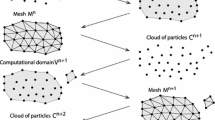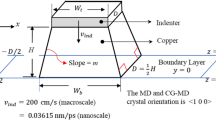Abstract
This paper demonstrates the predictive capabilities of a numerical model based on continuum mechanics for the simulation of run-out processes during landslides. It assesses a particle-based method that takes advantage of a double Lagrangian-Eulerian discretization and known as the material point method (MPM). Attention is given to the post-failure behaviour and, in particular, to the computation of important quantities such as run-out distance, maximum velocity and energy release. The MPM is a step forward in computational solid mechanics and has the potential to simulate large deformations such as those occurring during landslides. A validation is conducted based on simulations of two case studies of different scales, namely the Tokai-Hokuriku expressway failure in Japan and the Vajont landslide in Italy. The results show a very good agreement with field and other numerical observations.













Similar content being viewed by others
References
Abe K, Soga K, Bandara S (2014) Material point method for coupled hydromechanical problems. J Geotech Geoenviron Eng 140(3):1–16. doi:10.1061/(ASCE)GT.1943-5606.0001011
Abe K, Nakamura S, Nakamura H (2015) Large deformation analysis of slope models together with weak layers on shaking table by using material point method. In Computer Methods and Recent Advances in Geomechanics, London, pp 1805–1810
Albaba A, Lambert S, Nicot F (2015) DEM simulation of dry granular flow impacting a rigid wall. In Computer Methods and Recent Advances in Geomechanics, London, pp 1869–1874
Alonso EE, Pinyol NM, Yerro A (2014) Mathematical modelling of slopes. Procedia Earth Planet Sci 9:64–73. doi:10.1016/j.proeps.2014.06.002
Andersen S, Andersen L (2009) Material-point-method analysis of collapsing slopes. In: Proceedings of the 1st International Symposium on Computational Geomechanics (COMGEO I). Juan -les- Pins, France, pp 817–828
Andersen S, Andersen L (2010) Modelling of landslides with the material-point method. Comput Geosci 14(1):137–147. doi:10.1007/s10596-009-9137-y
Ashwood W (2014) Numerical model for the prediction of total dynamic landslide forces on flexible barriers. University of British Columbia, Dissertation
Bandara S, Soga K (2015) Coupling of soil deformation and pore fluid flow using material point method. Compt Rendus Geosci 63:199–214. doi:10.1016/j.compgeo.2014.09.009
Bardenhagen S, Kober EM (2004) The generalized interpolation material point method. Tech Sci Press 5(6):477–495
Bardenhagen SG, Guilkey JE, Roessig KM, Brackbill JU, Witzel WM, Foster JC (2001) An improved contact algorithm for the material point method and application to stress propagation in granular material. Tech Sci Press 2(4):209–522
Barla G, Paronuzzi P (2013) The 1963 Vajont landslide: 50th anniversary. Rock Mech Rock Eng 46(6):1267–1270. doi:10.1007/s00603-013-0483-7
Belytschko T, Liu WK, Moran B, Elkhodary K (2013). Nonlinear finite elements for continua and structures, John Wiley & Sons
Beuth L, Wieckowski Z, Vermeer PA (2011) Solution of quasi-static large-strain problems by the material point method. Int J Numer Anal Methods Geomech 35:1451–1465. doi:10.1002/nag.965
Bistacchi A, Massironi M, Superchi L, Zorzi L, Francese R, Giorgi M, Chistolini F, Genevois R (2013) A 3D geological model of the 1963 Vajont landslide. Ital J Eng Geol Environ 2013(6):531–539. doi:10.4408/IJEGE.2013-06.B-51
Boon C, Houlsby G, Utili S (2014) New insights into the 1963 Vajont slide using 2D and 3D distinct-element method analyses. Geotechnique 64(10):800–816. doi:10.1680/geot.14.P.041
Brighenti R, Segalini A, Ferrero AM (2013) Debris flow hazard mitigation: a simplified analytical model for the design of flexible barriers. Comput Geotech 54:1–15. doi:10.1016/j.compgeo.2013.05.010
Buzzi O, Pedroso DM, Giacomini A (2008) Caveats on the implementation of the generalized material point method. Tech Sci Press 31(2):85–106
Chen HX, Zhang LM (2014) Debris flow simulation considering distributed multiple source materials. In Numerical Methods in Geotechnical Engineering (NUMGE 2014), London, 339–343
Corominas J (1996) The angle of reach as a mobility index for small and large landslides. Can Geotech J 33(2):260–271. doi:10.1139/t96-005
Crosta G, Imposimato S, Roddeman D (2015) Landslide spreading, impulse water waves and modelling of the Vajont rockslide. Rock Mech Rock Eng. doi:10.1007/s00603-015-0769-z
de Souza Neto EA, Peric D, Owen DRJ (2008) Computational methods for plasticity: theory and applications, John Wiley & Sons
Griffiths DV, Lane PA (1999) Slope stability analysis by finite elements. Geotechnique 49(3):387–403. doi:10.1680/geot.1999.49.3.387
Higo Y, Nishimura D, Oka F et al (2015) Dynamic analysis of unsaturated embankment considering the seepage flow by a GIMP-FDM coupled method. In Computer Methods and Recent Advances in Geomechanics, London, pp 1761–1766
Hsü KJ (1975) Catastrophic debris stream (sturtzstroms) generated by rockfall. Bull Geol Soc Am 86(1):129–140. doi:10.1130/0016-7606(1975)86<129:CDSSGB>2.0.CO;2
Huang J, da Silva MV, Krabbenhoft K (2013) Three-dimensional granular contact dynamics with rolling resistance. Comput Geotech 49:289–298. doi:10.1016/j.compgeo.2012.08.007
Hughes TJ (1984) Numerical implementation of constitutive models: rate-independent deviatoric plasticity. In Theoretical Foundation for Large-Scale Computations of Nonlinear Material Behavior, Dordrecht, pp 29–63
Hungr O (1995) A model for the runout analysis of rapid flow slides, debris flows, and avalanches. Can Geotech J 32:610–623. doi:10.1139/t95-063
Hungr O, Morgan GC, Kellerhals R (1984) Quantitative analysis of debris torrent hazards for design of remedial measures. Can Geotech J 21:663–677. doi:10.1139/t84-073
Hungr O, Leroueil S, Picarelli L (2014) The Varnes classification of landslide types, an update. Landslides 11(2):167–194. doi:10.1007/s10346-013-0436-y
Jassim I, Stolle D, Vermeer P (2013) Two-phase dynamic analysis by material point method. Int J Numer Anal Meth Geomech 37(15):2502–2522. doi:10.1002/nag.2146
Kerswell RR (2005) Dam break with Coulomb friction: a model for granular slumping? Phys Fluids 17(2005):1–16. doi:10.1063/1.1870592
Kilburn CRJ, Petley DN (2003) Forecasting giant, catastrophic slope collapse: lessons from Vajont, northern Italy. Geomorphology 54(1-2):21–32. doi:10.1016/S0169-555X(03)00052-7
Kishi N, Ikeda K, Konno H, Kawase R (2000) Prototype impact test on rockfall retaining walls and its numerical simulation. Struct Under Shock Impact VI: 1-10
Krabbenhoft K, Lyamin AV, Huang J, Vicente da Silva M (2012) Granular contact dynamics using mathematical programming methods. Comput Geotech 43:165–176. doi:10.1016/j.compgeo.2012.02.006
Lacaze L, Kerswell RR (2009) Axisymmetric granular collapse: a transient 3D flow test of viscoplasticity. Phys Rev Lett 102(March):3–6. doi:10.1103/PhysRevLett.102.108305
Lacaze L, Phillips JC, Kerswell RR (2008) Planar collapse of a granular column: experiments and discrete element simulations. Phys Fluids 20:1–12. doi:10.1063/1.2929375
Lagrée P-Y, Staron L, Popinet S (2011) The granular column collapse as a continuum: validity of a two-dimensional Navier–Stokes model with a μ(I)-rheology. J Fluid Mech 686(c):378–408. doi:10.1017/jfm.2011.335
Lajeunesse E, Mangeney-Castelnau A, Vilotte P (2004) Spreading of a granular mass on a horizontal plane. Phys Fluids 16(7):2371–2381. doi:10.1063/1.1736611
Legros F (2002) The mobility of long-runout landslides. Eng Geol 63:301–331. doi:10.1016/S0013-7952(01)00090-4
Lemiale V, Nairn J, Hurmane A (2010) Material point method simulation of equal channel angular pressing involving large plastic strain and contact through sharp corners. Tech Sci Press 70(1):41–66
Lian YP, Zhang X, Liu Y (2012) An adaptive finite element material point method and its application in extreme deformation problems. Comput Methods Appl Mech Eng 241–244:275–285. doi:10.1016/j.cma.2012.06.015
Llano-Serna MA (2012) Aplicação do Método do Ponto Material (MPM) a problemas geotécnicos (In Portuguese). Dissertation, University of Brasilia
Lo C-M, Lee C-F, Chou H-T, Lin M-L (2013) Landslide at Su-Hua highway 115.9k triggered by typhoon Megi in Taiwan. Landslides 11(2):293–304. doi:10.1007/s10346-013-0435-z
Lube G, Huppert HE, Sparks RSJ, Hallworth MA (2004) Axisymmetric collapses of granular columns. J Fluid Mech 508:175–199. doi:10.1017/S0022112004009036
Lube G, Huppert H, Sparks R, Freundt A (2005) Collapses of two-dimensional granular columns. Phys Rev E 72(4):1–10. doi:10.1103/PhysRevE.72.041301
Mangeney-Castelnau A, Bouchut F, Vilotte JP, Lajeunesse E, Aubertin A, Pirulli M (2005) On the use of Saint Venant equations to simulate the spreading of a granular mass. J Geophys Res B Solid Earth 110:1–17. doi:10.1029/2004JB003161
Mast C, Arduino P, Mackenzie-Helnwein P, Miller GR (2014a) Simulating granular column collapse using the material point method. Acta Geotech 10(1):101–116. doi:10.1007/s11440-014-0309-0
Mast CM, Arduino P, Miller GR, Mackenzie-Helnwein P (2014b) Avalanche and landslide simulation using the material point method: flow dynamics and force interaction with structures. Comput Geosci 18(5):817–830. doi:10.1007/s10596-014-9428-9
McDougall S, Hungr O (2004) A model for the analysis of rapid landslide motion across three-dimensional terrain. Can Geotech J 41:1084–1097. doi:10.1139/t04-052
Muller-Salzburg L (1987) The Vajont catastrophe—a personal review. Eng Geol 24(1-4):423–444. doi:10.1016/0013-7952(87)90078-0
Nairn JA (2012) Open-source mpm and fea software – nairnmpm and nairnfea, http://osupdocs.forestry.oregonstate.edu/index.php/main_page (visited 2014)
Nairn JA (2013) Modeling imperfect interfaces in the material point method using multimaterial methods. Comput Model Eng Sci 1(1):1–15
Numada M, Konagai K, Ito H, Johansson J (2003) Material point method for run-out analysis of earthquake-induced long-traveling soil flows. JSCE J Earthq Eng 27:3–6. doi:10.11532/proee2003.27.227
Paronuzzi P, Bolla A (2012) The prehistoric Vajont rockslide: an updated geological model. Geomorphology 169–170:165–191. doi:10.1016/j.geomorph.2012.04.021
Pastor M, Blanc T, Haddad B, Drempetic V, Morles MS, Dutto P, Stickle MM, Mira P, Merodo JAF (2014) Depth averaged models for fast landslide propagation: mathematical, rheological and numerical aspects. Arch Comput Methods Eng 22(1):67–104. doi:10.1007/s11831-014-9110-3
Pedroso DM (2015a) A consistent u-p formulation for porous media with hysteresis. Int J Numer Methods Eng 101(8):606–634. doi:10.1002/nme.4808
Pedroso DM (2015b) A solution to transient seepage in unsaturated porous media. Comput Methods Appl Mech Eng 285:791–816. doi:10.1016/j.cma.2014.12.009
Peila D, Ronco C (2009) Technical note: design of rockfall net fences and the new ETAG 027 European guideline. Nat Hazards Earth Syst Sci 9:1291–1298
Sassa K, Dang K, He B, Takara K, Inoue K, Nagai O (2014) A new high-stress undrained ring-shear apparatus and its application to the 1792 Unzen–Mayuyama megaslide in Japan. Landslides 11(5):827–842. doi:10.1007/s10346-014-0501-1
Sawada K, Moriguchi S, Yashima A, Zhang F, Uzuoka R (2004) Large deformation analysis in geomechanics using CIP method. JSME Int J 47(4):735–743. doi:10.1299/jsmeb.47.735
Sawada K, Moriguchi S, Oda K (2015) 3D simulation of an actual snow avalanche. In Computer Methods and Recent Advances in Geomechanics, London, pp 495–500
Shin W, Miller GR, Arduino P, Mackenzie-Helnwein P (2010) Dynamic meshing for material point method computations. Eng Technol 48(9):84–92
Skempton A, Hutchinson J (1969) Stability of natural slopes and embankment foundations. In: In Proc 7th Int Conf on Soil Mech and Found Eng State-of-art, México., pp 291–340
Staron L, Hinch EJ (2005) Study of the collapse of granular columns using DEM numerical simulation. J Fluid Mech 545:1–27. doi:10.1017/S0022112005006415
Staron L, Hinch EJ (2007) The spreading of a granular mass: role of grain properties and initial conditions. Granul Matter 9(3-4):205–217. doi:10.1007/s10035-006-0033-z
Sulsky D, Chenb Z, Schreyer HL (1994) A particle method for history-dependent materials. Comput Methods Appl Mech Eng 118(1-2):179–186. doi:10.1016/0045-7825(94)90112-0
Sulsky D, Zhou SJ, Schreyer HL (1995) Application of a particle-in-cell method to solid mechanics. Comput Phys Commun 87(1-2):236–252. doi:10.1016/0010-4655(94)00170-7
Thompson EL, Huppert HE (2007) Granular column collapses: further experimental results. J Fluid Mech 575:177–186. doi:10.1017/S0022112006004563
Vacondio R, Mignosa P, Pagani S (2013) 3D SPH numerical simulation of the wave generated by the Vajont rockslide. Adv Water Resour 59:146–156. doi:10.1016/j.advwatres.2013.06.009
Voight B, Faust C (1982) Frictional heat and strength loss in some rapid landslides. Geotechnique 32(1):43–54. doi:10.1680/geot.1982.32.1.43
Ward S, Day S (2011) The 1963 landslide and flood at Vaiont reservoir Italy. A tsunami ball simulation. Ital J Geosci 130(1):16–26. doi:10.3301/IJG.2010.21
Wieckowski Z, Youn SK, Yeon JH (1999) A particle-in-cell solution to the silo discharging problem. Int J Numer Methods Eng 45(9):1203–1225. doi:10.1002/(SICI)1097-0207(19990730)45:9<1203::AID-NME626>3.0.CO;2-C
Wolter A, Havaej M, Zorzi L, Stead D, Clague J, Ghirotti M, Genevois R (2013) Exploration of the kinematics of the 1963 Vajont slide, Italy, using a numerical modelling toolbox. Ital J Eng Geol Environ 6:599–612
Wolter A, Stead D, Clague J (2014) A morphologic characterisation of the 1963 Vajont Slide, Italy, using long-range terrestrial photogrammetry. Geomorphology 206:147–164. doi:10.1016/j.geomorph.2013.10.006
Wriggers P (2006) Computational contact mechanics. Second edi, Springer, Berlin Heidelberg
Ye G (2004) Numerical study on the mechanical behavior of progressive failure of slope by 2D and 3D FEM. Dissertation, Gifu University
Zenit R (2005) Computer simulations of the collapse of a granular column. Phys Fluids 17(3):1–4. doi:10.1063/1.1862240
Zhang X, Krabbenhoft K, Pedroso DM, Lyamin AV, Sheng D, da Silva MV, Wang D (2013) Particle finite element analysis of large deformation and granular flow problems. Comput Geotech 54:133–142. doi:10.1016/j.compgeo.2013.07.001
Zienkiewicz O, Taylor R (2013) The Finite Element Method Set. Seventh edition. Elsevier Science & Technology Books
Acknowledgments
The authors acknowledge the support from the Coordination for the Improvement of Higher Level Education Personnel (CAPES), the Brazilian Research Council (CNPq) and the Australian Research Council (project DE120100163).
Author information
Authors and Affiliations
Corresponding author
Rights and permissions
About this article
Cite this article
Llano-Serna, M.A., Farias, M.M. & Pedroso, D.M. An assessment of the material point method for modelling large scale run-out processes in landslides. Landslides 13, 1057–1066 (2016). https://doi.org/10.1007/s10346-015-0664-4
Received:
Accepted:
Published:
Issue Date:
DOI: https://doi.org/10.1007/s10346-015-0664-4




